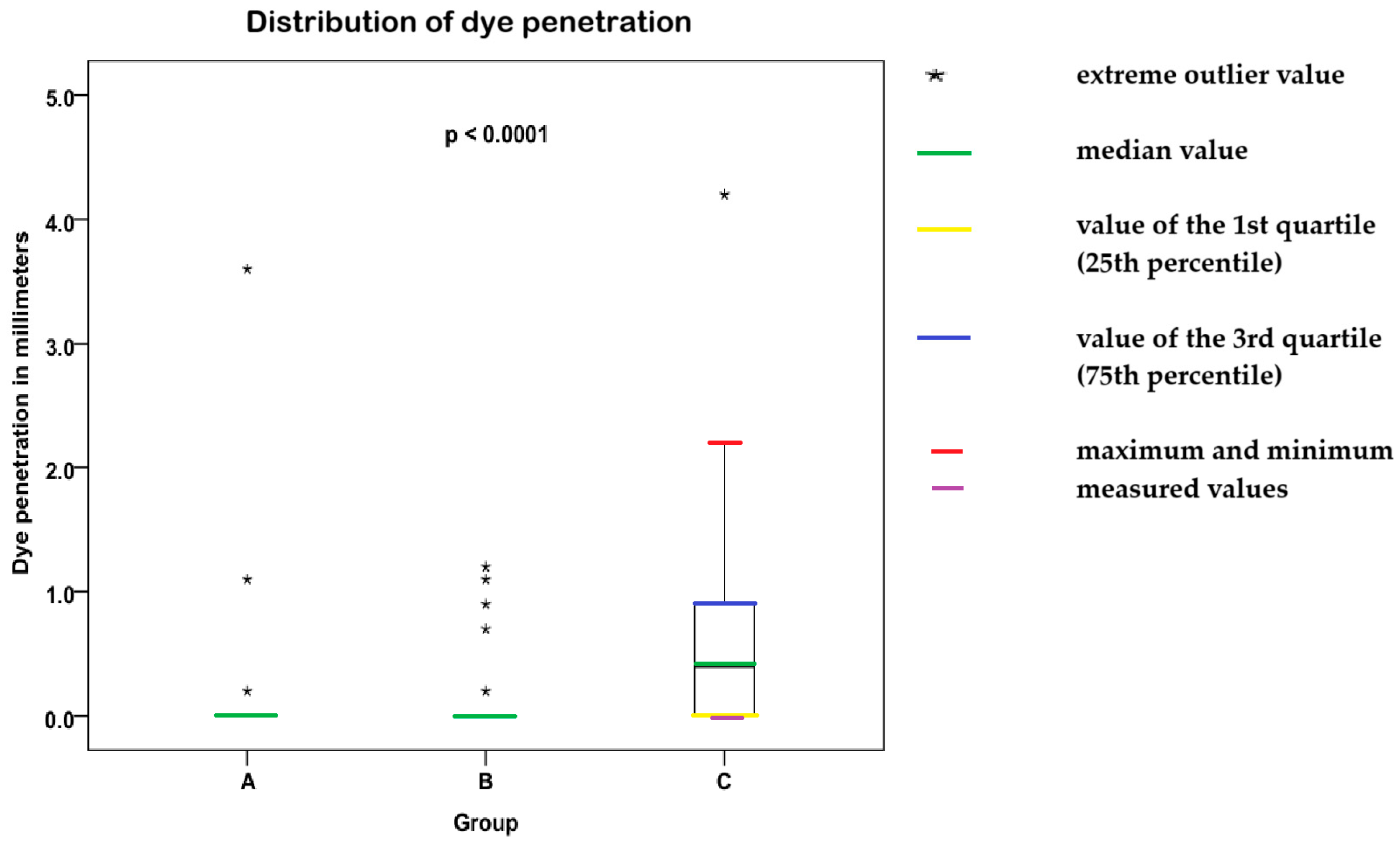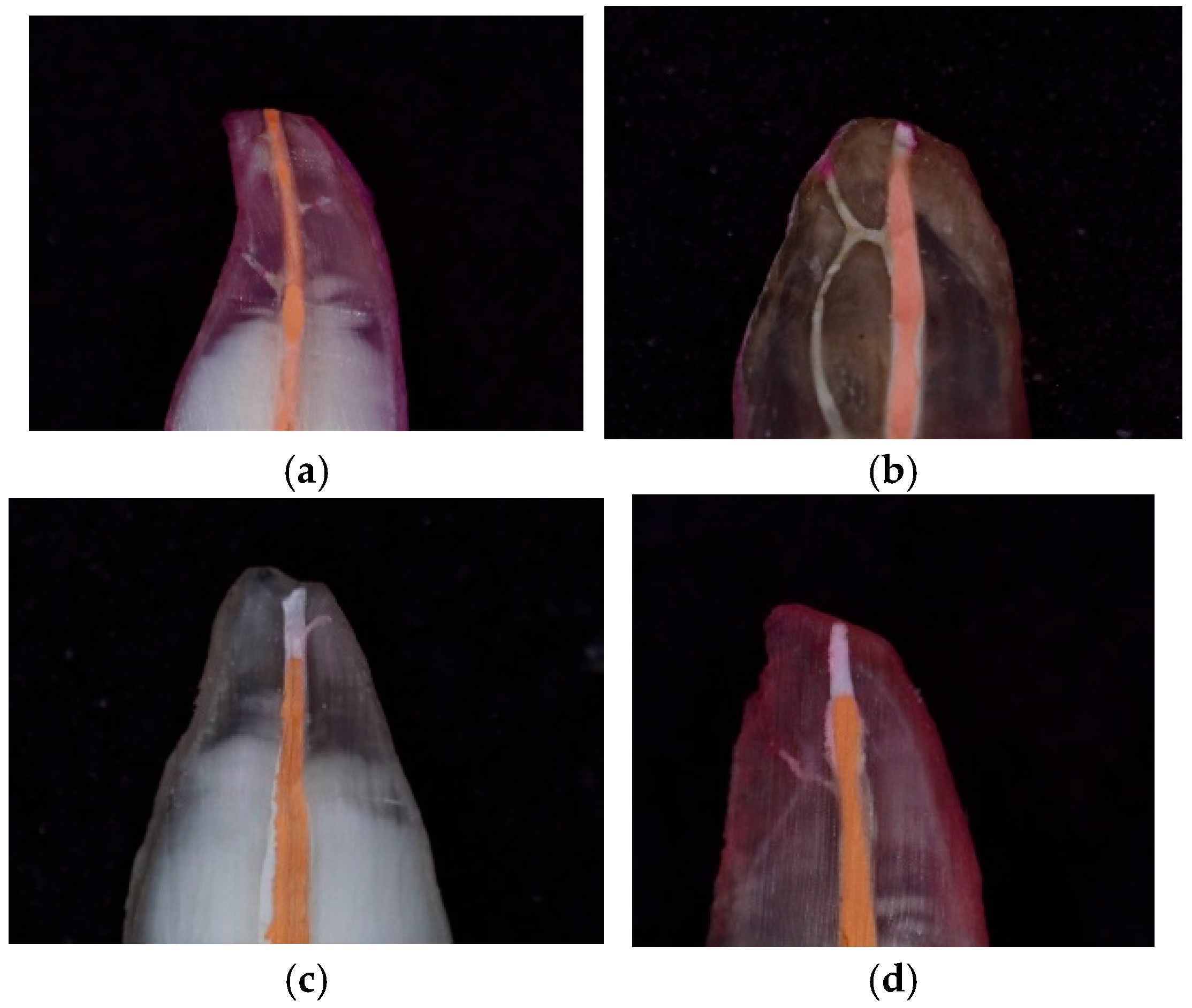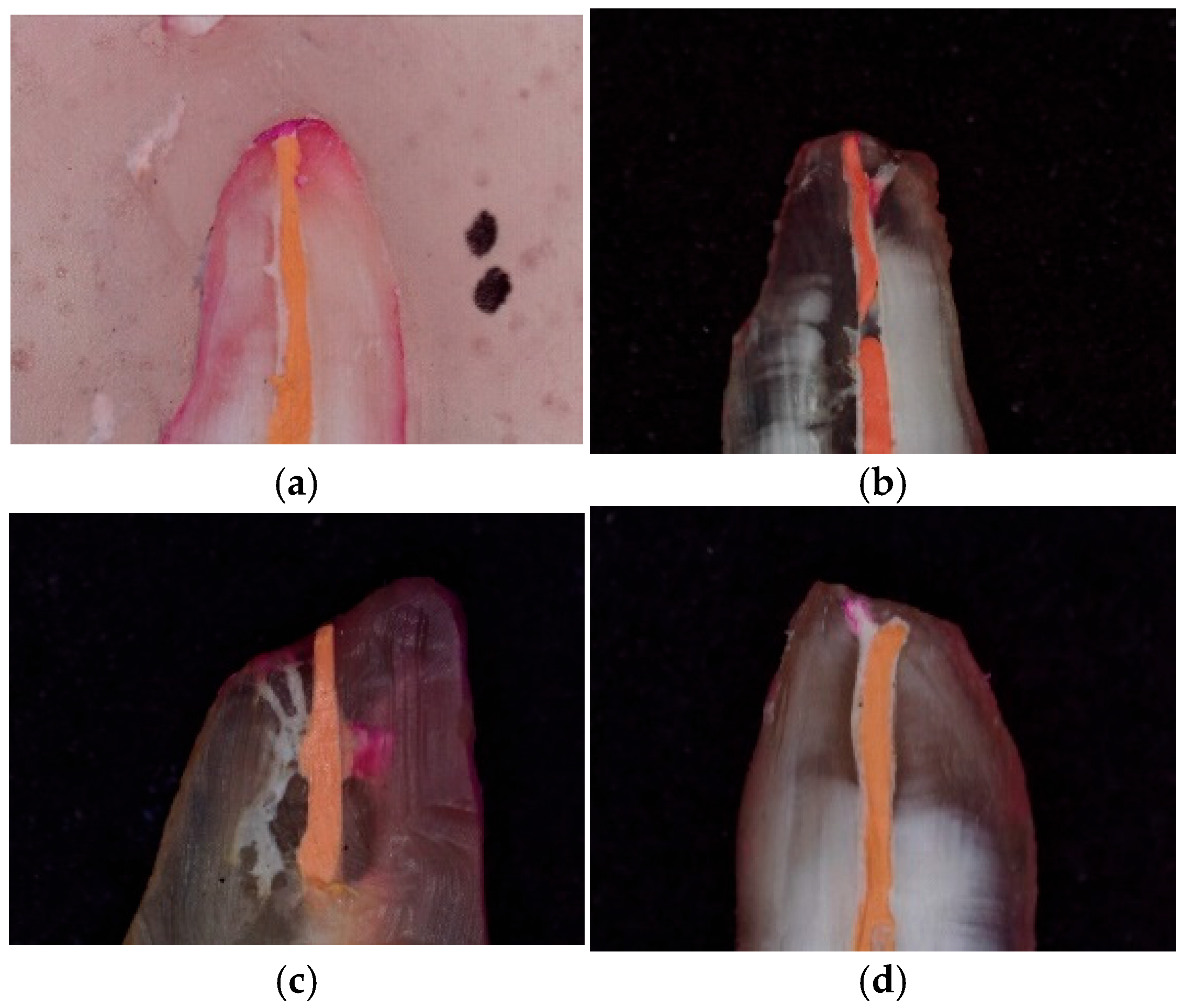Comparison of Apical Microleakage in Bioceramic and Resin-Based Endodontic Sealers with Conventional and Bioceramic Surface-Impregnated Gutta-Percha Points
Abstract
1. Introduction
2. Materials and Methods
2.1. Bioceramic Material Bioactive Management
2.2. Tooth Specimens
2.3. Placement of Root Canal Obturation
- (A)
- The first group was filled with BCB root canal sealer BioRoot RCS (Septodont, France) in combination with a gutta-percha point impregnated with bioceramic particles, TotalFill BC Points (FKG Dentaire, La Chaux-de-Fonds, Switzerland), using a cold hydraulic obturation technique. The BioRoot RCS material was mixed according to the manufacturer’s instructions (1 scoop of powder/5 drops of liquid) and repeatedly applied in large quantities to the canal on a selected gutta-percha point corresponding to the final instrumentation (ISO 30–40, taper 6%). After the final insertion, the point was shortened 1–2 mm below the level of the entrance to the canal with an ultrasonic tip without cooling and gently condensed with a cold plugger.
- (B)
- The second group was filled with a BCB root canal sealer, BioRoot RCS (Septodont, France), in combination with a calibrated gutta-percha point without surface treatment, Protaper Gold Conform Fit Gutta-Percha Points F3–F4 (Dentsply Sirona, USA), using a cold hydraulic obturation technique. The BioRoot RCS material was mixed according to the manufacturer’s instructions (1 scoop of powder/5 drops of liquid) and repeatedly applied in larger quantities to the canal on a selected gutta-percha point of the appropriate size. After the final insertion, the point was shortened 1–2 mm below the level of the entrance to the canal with an ultrasonic tip without cooling and gently condensed with a cold plugger.
- (C)
- The third group was filled with a poly-epoxide RB root canal sealer, AdSeal (Meta Biomed, Cheongju, Republic of Korea), in combination with a calibrated gutta-percha point without surface treatment, Protaper Gold Conform Fit Gutta-Percha Points F3-F4 (Dentsply Sirona, USA), using the warm vertical condensation technique. The AdSeal material was mixed according to the manufacturer’s instructions and introduced into the root canal in a very small amount on a gutta-percha point of the appropriate size. Using a hot plugger, the point was shortened approximately 5 mm from the apical stop and vertically condensed. After that, the remaining space of the canal was filled with an injection of heated gutta-percha and then condensed with a plugger in the vertical direction. The root canal filling was finished 1–2 mm below the level of the canal entrance.
2.4. Dye Penetration
2.5. Assessment of Dye Leakage
2.6. Evaluation of the Data Outcomes
2.7. Statistical Analysis
3. Results
- The Kruskal–Wallis comparison of the mean values, minimum values, maximum values, means, and standard deviations (SDs) is shown in Table 2. This method demonstrated a significant difference between individual groups in dye penetration length, p = 0.00003 ***. The percentage of the no dye penetration value (concurrently, also the minimum value) is 90% in group A, 83.3% in group B, and 40% in group C.
- Post-hoc Mann–Whitney U tests with Bonferroni correction were performed to compare each group’s specimen values. A p-value that is less than 0.05 is considered statistically significant and is marked red in the table; the results are shown in Table 3. According to the post-hoc Mann–Whitney U test, a statistically significant difference between groups A (BioRoot RCS/TotalFill BC Points) and C (AdSeal/ProtaperGold Points) was proven; p = 0.0003. Groups B and C also presented a statistically significant difference; p = 0.003.
- The Shapiro–Wilk test demonstrated that the quantitative data do not have a normal distribution. The distribution of the quantitative values is shown using a box graph (Figure 2).
4. Discussion
5. Conclusions
Author Contributions
Funding
Institutional Review Board Statement
Informed Consent Statement
Data Availability Statement
Conflicts of Interest
References
- Spoială, A.; Ilie, C.-I.; Ficai, D.; Ficai, A. Biomaterials. In Biomaterials and Tissue Engineering; Gunduz, O., Egles, C., Pérez, R.A., Ficai, D., Ustundag, C.B., Eds.; Springer International Publishing: Cham, Switzerland, 2023; pp. 97–129. [Google Scholar] [CrossRef]
- Dong, X.; Xu, X. Bioceramics in Endodontics: Updates and Future Perspectives. Bioengineering 2023, 10, 354. [Google Scholar] [CrossRef] [PubMed]
- Rautemaa, R.; Lauhio, A.; Cullinan, M.P.; Seymour, G.J. Oral infections and systemic disease—An emerging problem in medicine. Clin. Microbiol. Infect. 2007, 13, 1041–1047. [Google Scholar] [CrossRef]
- Niazi, S.A.; Bakhsh, A. Association between Endodontic Infection, Its Treatment and Systemic Health: A Narrative Review. Medicina 2022, 58, 931. [Google Scholar] [CrossRef] [PubMed]
- Li, X.; Kolltveit, K.M.; Tronstad, L.; Olsen, I. Systemic Diseases Caused by Oral Infection. Clin. Microbiol. Rev. 2000, 13, 547. [Google Scholar] [CrossRef] [PubMed]
- Cintra, L.T.; Estrela, C.; Azuma, M.M.; Queiroz, Í.O.; Kawai, T.; Gomes-Filho, J.E. Endodontic medicine: Interrelationships among apical periodontitis, systemic disorders, and tissue responses of dental materials. Braz. Oral Res. 2018, 32, e68. [Google Scholar] [CrossRef]
- Meirinhos, J.; Martins, J.N.; Pereira, B.; Baruwa, A.; Gouveia, J.; Quaresma, S.A.; Monroe, A.; Ginjeira, A. Prevalence of apical periodontitis and its association with previous root canal treatment, root canal filling length and type of coronal restoration—A cross-sectional study. Int. Endod. J. 2020, 53, 573–584. [Google Scholar] [CrossRef]
- Sritharan, A. Discuss That the Coronal Seal Is More Important Than the Apical Seal For Endodontic Success. Aust. Endod. J. 2002, 28, 112–115. [Google Scholar] [CrossRef]
- Microleakage in Endodontics. Available online: https://www.researchgate.net/publication/271598954_Microleakage_in_Endodontics (accessed on 28 January 2025).
- Jafari, F.; Rahimi, S.; Shahi, S.; Jafari, S. Endodontic microleakage studies: Correlation among different methods, clinical relevance, and potential laboratory errors. Minerva Stomatol. 2017, 66, 169–177. [Google Scholar] [CrossRef]
- Kazem, M.; Eghbal, M.J.; Asgary, S. Comparison of Bacterial and Dye Microleakage of Different Root-End Filling Materials. Iran. Endod. J. 2010, 5, 17–22. [Google Scholar]
- Jafari, F.; Jafari, S. Importance and methodologies of endodontic microleakage studies: A systematic review. J. Clin. Exp. Dent. 2017, 9, 812–821. [Google Scholar] [CrossRef][Green Version]
- Zhang, Y.; Chen, Y.P. Bioengineering of a human whole tooth: Progress and challenge. Cell. Regen. 2014, 3, 3–8. [Google Scholar] [CrossRef] [PubMed]
- Li, Q.; Faux, P.; Winchester, E.W.; Yang, G.; Chen, Y.; Ramírez, L.M.; Fuentes-Guajardo, M.; Poloni, L.; Steimetz, E.; Gonzalez-José, R.; et al. PITX2 expression and Neanderthal introgression in HS3ST3A1 contribute to variation in tooth dimensions in modern humans. Curr. Biol. 2025, 35, 131–144.e6. [Google Scholar] [CrossRef] [PubMed]
- Camilleri, J.; Atmeh, A.; Li, X.; Meschi, N. Present status and future directions: Hydraulic materials for endodontic use. Int. Endod. J. 2022, 55, 710–777. [Google Scholar] [CrossRef]
- Somolová, L.; Zapletalová, Z.; Rosa, M.; Novotná, B.; Voborná, I.; Morozova, Y. Bioceramic-Based Root Canal Sealers. Česká Stomatol./Prakt. Zubn. Lékařství 2021, 121, 116–124. [Google Scholar] [CrossRef]
- Ortega, M.A.; Rios, L.; Fraile Martínez, O.; Liviu Boaru, D.; Leon Oliva, D.D.; Barrena Blázquez, S.; Pereda Cerquella, C.; Garrido Gil, M.J.; Manteca, L.; Buján, J.; et al. Bioceramic versus traditional biomaterials for endodontic sealers according to the ideal properties. Histol. Histopathol. 2024, 39, 279–292. [Google Scholar] [CrossRef]
- Camilleri, J. BioRoot TM RCS Endo Sealer or Biological Filler? CliniCal Insights. Available online: https://www.bioroot.com.br/arquivos/Josette-Camilleri-BioRoot-RCS-Endo-sealer-or-biological-filler.pdf (accessed on 14 May 2025).
- Camilleri, J. BioRoot TM RCS Is a Paradigm Shift for Root Canal Obturation Possible? Available online: https://cdn2.hubspot.net/hubfs/4299081/bioroot%20article%20Josette%20Camilleri%20scientific%20insights.pdf (accessed on 14 May 2025).
- Somolová, L.; Zapletalová, Z.; Rosa, M.; Harvan, Ľ.; Voborná, I.; Morozova, Y. Bioceramic-Based Root Canal Sealers—Use in Endodontics. Česká Stomatol./Prakt. Zubn. Lékařství 2021, 121, 41–47. [Google Scholar] [CrossRef]
- Cardinali, F.; Camilleri, J. A critical review of the material properties guiding the clinician’s choice of root canal sealers. Clin. Oral. Investig. 2023, 27, 4147–4155. [Google Scholar] [CrossRef]
- Santos-Junior, A.O.; Tanomaru-Filho, M.; Pinto, J.C.; Tavares, K.I.M.C.; Torres, F.F.E.; Guerreiro-Tanomaru, J.M. Effect of obturation technique using a new bioceramic sealer on the presence of voids in flattened root canals. Braz. Oral Res. 2021, 35, e028. [Google Scholar] [CrossRef]
- Rekha, R.; Kavitha, R.; Venkitachalam, R.; Prabath, S.V.; Deepthy, S.; Krishnan, V. Comparison of the sealing ability of bioceramic sealer against epoxy resin based sealer: A systematic review & meta-analysis. J. Oral Biol. Craniofac. Res. 2023, 13, 28–35. [Google Scholar] [CrossRef]
- Huth, K.C.; Wuersching, S.N.; Benz, L.; Kist, S.; Kollmuss, M. In Vitro Microscopical and Microbiological Assessment of the Sealing Ability of Calcium Silicate-Based Root Canal Sealers. J. Funct. Biomater. 2024, 15, 341. [Google Scholar] [CrossRef]
- Asawaworarit, W.; Pinyosopon, T.; Kijsamanmith, K. Comparison of apical sealing ability of bioceramic sealer and epoxy resin-based sealer using the fluid filtration technique and scanning electron microscopy. J. Dent. Sci. 2020, 15, 186–192. [Google Scholar] [CrossRef]
- Kazemipoor, M.; Modaresi, J.; Zandi, H.; Vasee, N.; Farzaneh, V. Lack of correlation between microbial penetration method and electro chemical technique for assessment of leakage through the root canal fillings. Contemp. Clin. Dent. 2014, 5, 71. [Google Scholar] [CrossRef] [PubMed]
- Alhabdan, A.A. Review of microleakage evaluation tools. J. Int. Oral Health 2017, 9, 141–145. [Google Scholar] [CrossRef]
- Perry, C.; Kulild, J.C.; Walker, M.P. Comparison of warm vertical compaction protocols to obturate artificially created defects in the apical one-third. J. Endod. 2013, 39, 1176–1178. [Google Scholar] [CrossRef]
- Jaha, H.S. Hydraulic (Single Cone) Versus Thermogenic (Warm Vertical Compaction) Obturation Techniques: A Systematic Review. Cureus 2024, 16, e62925. [Google Scholar] [CrossRef] [PubMed]
- Chybowski, E.A.; Glickman, G.N.; Patel, Y.; Fleury, A.; Solomon, E.; He, J. Clinical Outcome of Non-Surgical Root Canal Treatment Using a Single-cone Technique with Endosequence Bioceramic Sealer: A Retrospective Analysis. J. Endod. 2018, 44, 941–945. [Google Scholar] [CrossRef] [PubMed]
- Albakhakh, B.; Al-Saedi, A.; Al-Taee, R.; Nahidh, M. Rapid Apical Healing with Simple Obturation Technique in Response to a Calcium Silicate-Based Filling Material. Int. J. Dent. 2022, 1, 6958135. [Google Scholar] [CrossRef]
- Bardini, G.; Casula, L.; Ambu, E.; Musu, D.; Mercadè, M.; Cotti, E. A 12-month follow-up of primary and secondary root canal treatment in teeth obturated with a hydraulic sealer. Clin. Oral Investig. 2021, 25, 2757–2764. [Google Scholar] [CrossRef]
- Zavattini, A.; Knight, A.; Foschi, F.; Mannocci, F. Clinical Medicine Outcome of Root Canal Treatments Using a New Calcium Silicate Root Canal Sealer: A Non-Randomized Clinical Trial. J. Clin. Med. 2020, 9, 782. [Google Scholar] [CrossRef]
- Song, M.; Park, M.-G.; Kwak, S.-W.; Kim, R.H.; Ha, J.-H.; Kim, H.-C. Pilot Evaluation of Sealer-Based Root Canal Obturation Using Epoxy-Resin-Based and Calcium-Silicate-Based Sealers: A Randomized Clinical Trial. Materials 2022, 15, 5146. [Google Scholar] [CrossRef]
- Fonseca, B.; Coelho, M.S.; Bueno, C.E.D.S.; Fontana, C.E.; De Martin, A.S.; Rocha, D.G.P. Assessment of Extrusion and Postoperative Pain of a Bioceramic and Resin-Based Root Canal Sealer. Eur. J. Dent. 2019, 13, 343–348. [Google Scholar] [CrossRef] [PubMed]
- Jurič, R.; Vidmar, G.; Blagus, R.; Jan, J. Factors associated with the outcome of root canal treatment—A cohort study conducted in a private practice. Int. Endod. J. 2024, 57, 377–393. [Google Scholar] [CrossRef] [PubMed]
- Aminoshariae, A.; Primus, C.; Kulild, J.C. Tricalcium silicate cement sealers: Do the potential benefits of bioactivity justify the drawbacks? J. Am. Dent. Assoc. 2022, 153, 750–760. [Google Scholar] [CrossRef]
- Hamdy, T.M.; Galal, M.M.; Ismail, A.G.; Saber, S. Physicochemical properties of AH plus bioceramic sealer, Bio-C Sealer, and ADseal root canal sealer. Head Face Med. 2024, 20, 2. [Google Scholar] [CrossRef]
- Nouroloyouni, A.; Samadi, V.; Milani, A.S.; Noorolouny, S.; Valizadeh-Haghi, H. Single Cone Obturation versus Cold Lateral Compaction Techniques with Bioceramic and Resin Sealers: Quality of Obturation and Push-Out Bond Strength. Int. J. Dent. 2023, 2023, 3427151. [Google Scholar] [CrossRef]
- Hu, J.; Zhu, Y.; Deng, S.; Wang, Z.; He, F. Outcome of root canal treatment using warm vertical compaction with bioceramic and resin-based sealers: A randomised clinical trial. Aust. Endod. J. 2023, 49, 170–178. [Google Scholar] [CrossRef] [PubMed]
- Roizenblit, R.N.; Soares, F.O.; Lopes, R.T.; Santos, B.C.D.; Gusman, H. Root canal filling quality of mandibular molars with EndoSequence BC and AH Plus sealers: A micro-CT study. Aust. Endod. J. 2020, 46, 82–87. [Google Scholar] [CrossRef] [PubMed]
- Yu, Y.; Yuan, C.Y.; Yin, X.Z.; Wang, X.Y. Assessment of isthmus filling using two obturation techniques performed by students with different levels of clinical experience. J. Dent. Sci. 2024, 19, 169. [Google Scholar] [CrossRef]
- Candeiro, G.T.; Lavor, A.B.; Lima, I.T.; Vasconcelos, B.C.; Gomes, N.V.; Iglecias, E.F.; Gavini, G. Penetration of bioceramic and epoxy-resin endodontic cements into lateral canals. Braz. Oral Res. 2019, 33, e049. [Google Scholar] [CrossRef]
- Manjila, J.C.; Vijay, R.; Srirekha, A.; Santhosh, L.; Reddy, J.; Srinivasan, A. Apical microleakage in root canals with separated rotary instruments obturated with different endodontic sealers. J. Conserv. Dent. 2022, 25, 274. [Google Scholar]
- Liu, H.; Shen, Y. Endodontic Retreatment of a Mandibular Second Molar with a C-shaped Root Canal Configuration: A Case Report. Cureus 2024, 16, e52812. [Google Scholar] [CrossRef] [PubMed]
- Wisawawatin, D.; Yanpiset, K.; Banomyong, D.; Jantarat, J. Gap volume and sealer penetration of C-shaped root canals obturated with cold hydraulic technique and calcium silicate sealer. Aust. Endod. J. 2023, 49, 99–106. [Google Scholar] [CrossRef] [PubMed]
- Vishwanath, V.; Rao, H.M. Gutta-percha in endodontics—A comprehensive review of material science. J. Conserv. Dent. 2019, 22, 216. [Google Scholar] [CrossRef] [PubMed]
- Zhang, W.; Li, Z.; Peng, B. Ex vivo cytotoxicity of a new calcium silicate-based canal filling material. Int. Endod. J. 2010, 43, 769–774. [Google Scholar] [CrossRef]
- Quaresma, S.A.; Alves dos Santos, G.N.; Silva-Sousa, A.C.; Camargo, R.V.; Silva-Sousa, Y.T.; Lopes-Olhê, F.C.; Mazzi-Chaves, J.F.; Sousa-Neto, M.D. Influence of bioceramic cones on the quality of root canal filling relative to bond strength and adaptation of the adhesive interface. Clin. Oral Investig. 2023, 27, 7919–7933. [Google Scholar] [CrossRef]
- Eltair, M.; Pitchika, V.; Hickel, R.; Kühnisch, J.; Diegritz, C. Evaluation of the interface between gutta-percha and two types of sealers using scanning electron microscopy (SEM). Clin. Oral Investig. 2018, 22, 1631–1639. [Google Scholar] [CrossRef]




| Materials | Manufacturer | Mixing | Chemical Composition |
|---|---|---|---|
| BioRoot RCS | Septodont Saint-Maur-des-Fossés, France | manual mixing with spatula on a mixing plate: 5 drops of liquid with 1 scoop of powder | powder: tricalcium silicate, zirconium dioxide, povidone liquid: water, calcium chloride, polycarboxylate |
| AdSeal | MetaBiomed Cheongju, Republic of Korea | manual mixing with spatula on a mixing plate: dual syringe: 9 g of base and 4.5 g of catalyst paste | base paste: epoxy resin oligomer, hydroxyethyl salicylate, bismuth III carbonate catalyst paste: poly-butanediol amino benzoate, calcium phosphate, bismuth III carbonate |
| Group | N | Mean | Median | Minimum | Maximum | SD | p |
|---|---|---|---|---|---|---|---|
| A | 30 | 0.16 | 0.00 | 0.00 | 3.60 | 0.68 | 0.00003 *** |
| B | 0.14 | 0.00 | 0.00 | 1.20 | 0.34 | ||
| C | 0.66 | 0.40 | 0.00 | 4.20 | 0.92 |
| Group Comparisons | p |
|---|---|
| A versus B | 1.000 |
| B versus C | 0.003 ** |
| A versus C | 0.0003 *** |
Disclaimer/Publisher’s Note: The statements, opinions and data contained in all publications are solely those of the individual author(s) and contributor(s) and not of MDPI and/or the editor(s). MDPI and/or the editor(s) disclaim responsibility for any injury to people or property resulting from any ideas, methods, instructions or products referred to in the content. |
© 2025 by the authors. Licensee MDPI, Basel, Switzerland. This article is an open access article distributed under the terms and conditions of the Creative Commons Attribution (CC BY) license (https://creativecommons.org/licenses/by/4.0/).
Share and Cite
Somolová, L.; Morozova, Y.; Voborná, I.; Rosa, M.; Novotná, B.; Holík, P.; Langová, K. Comparison of Apical Microleakage in Bioceramic and Resin-Based Endodontic Sealers with Conventional and Bioceramic Surface-Impregnated Gutta-Percha Points. Ceramics 2025, 8, 65. https://doi.org/10.3390/ceramics8020065
Somolová L, Morozova Y, Voborná I, Rosa M, Novotná B, Holík P, Langová K. Comparison of Apical Microleakage in Bioceramic and Resin-Based Endodontic Sealers with Conventional and Bioceramic Surface-Impregnated Gutta-Percha Points. Ceramics. 2025; 8(2):65. https://doi.org/10.3390/ceramics8020065
Chicago/Turabian StyleSomolová, Lucia, Yuliya Morozova, Iva Voborná, Matej Rosa, Barbora Novotná, Pavel Holík, and Kateřina Langová. 2025. "Comparison of Apical Microleakage in Bioceramic and Resin-Based Endodontic Sealers with Conventional and Bioceramic Surface-Impregnated Gutta-Percha Points" Ceramics 8, no. 2: 65. https://doi.org/10.3390/ceramics8020065
APA StyleSomolová, L., Morozova, Y., Voborná, I., Rosa, M., Novotná, B., Holík, P., & Langová, K. (2025). Comparison of Apical Microleakage in Bioceramic and Resin-Based Endodontic Sealers with Conventional and Bioceramic Surface-Impregnated Gutta-Percha Points. Ceramics, 8(2), 65. https://doi.org/10.3390/ceramics8020065








